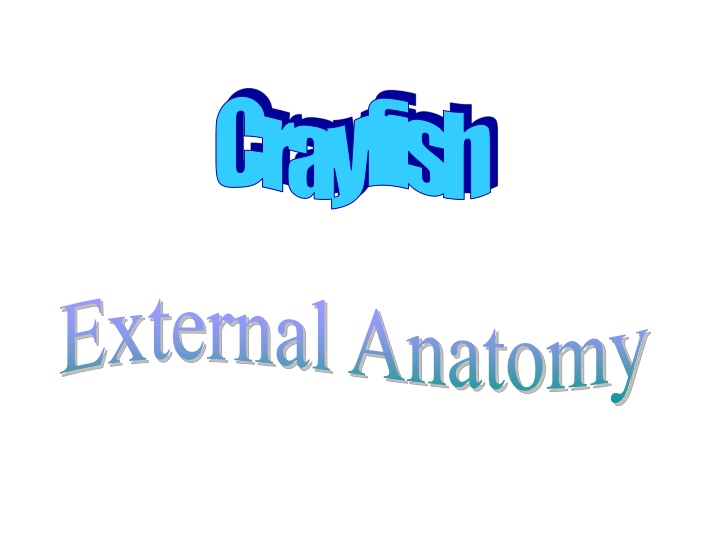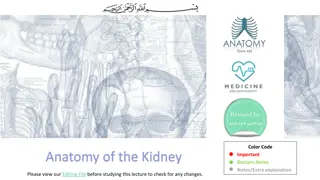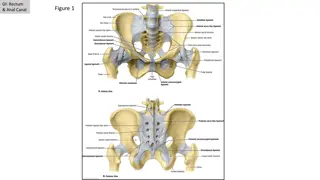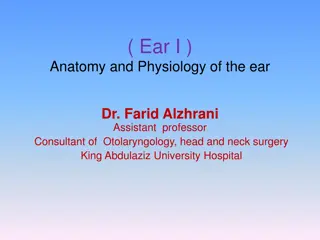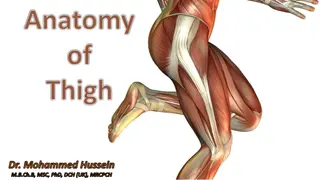Crayfish External Anatomy: A Detailed Exploration
Discover the external anatomy of a crayfish through detailed descriptions and images. Explore the dorsal and ventral views, diving into the features such as uropods, telson, chelipeds, antennae, swimmerets, and more. Learn about the mouth area, including walking legs, maxillipeds, mandibles, and sensory organs. Dive deeper into the male anatomy, focusing on the modified swimmerets used for sperm transfer.
Download Presentation

Please find below an Image/Link to download the presentation.
The content on the website is provided AS IS for your information and personal use only. It may not be sold, licensed, or shared on other websites without obtaining consent from the author.If you encounter any issues during the download, it is possible that the publisher has removed the file from their server.
You are allowed to download the files provided on this website for personal or commercial use, subject to the condition that they are used lawfully. All files are the property of their respective owners.
The content on the website is provided AS IS for your information and personal use only. It may not be sold, licensed, or shared on other websites without obtaining consent from the author.
E N D
Presentation Transcript
Crayfish External Anatomy
Dorsal View These are the crayfish's uropods. It has two pairs of these appendages. 1. This is the crayfish's telson. It is used in combination with the uropods for backwards escape swimming. 2. This is the crayfish's abdomen. Its paired appendages are the swimmerets and uropods. 3. This is the crayfish's cephalothorax. It is covered with a carapace that offers some protection from predators. 4. 5. This is the cephalic groove, a lateral seam in the carapace between the head and thorax regions. These are two of 8 (4 pairs) of walking legs. Each walking leg has an attached gill that is found just beneath the exoskeleton. 6. This is the crayfish's left cheliped. These appendages are used for defense and food handling. 7.. 8. This is the crayfish's left eye. 9. This region of the carapace is called the rostrum. a This is the crayfish's left long antenna, a sensory organ.
Mouth Area 1. The crayfish has four pairs of walking legs. 2. The arrows point to appendages off of several of the crayfish's 3 pairs of maxillipeds. 3. The arrow points to the crayfish's right mandible. The mouth is in this area. 4. The arrow points to a renal pore, an opening of the crayfish's excretory organ, the green gland. 5. The arrow points to one of the long antennae. 6. The arrow points to one of the short antennae (or antennules). 7. This is the crayfish's right cheliped.
Ventral View These are the crayfish's uropods. It has two pairs of these appendages. 1. These are the crayfish's swimmerets. There are five pairs of these appendages. 2. These are the crayfish's walking legs. There are four pairs of these appendages. 3. This is the crayfish's right cheliped. These appendages are used for defense and food handling. 4. This specimen is a male. It's first two pair of swimmerets are elongate and form a sperm transfer organ. In females, the first two pairs of swimmerets are unmodified. 5. 6. This is the crayfish's right long antenna, a sensory organ.
Male This is a swimmeret, a short, filamentous appendage. 1. The pin points to the male genetal opening. Sperm are released here and 2. delivered by the male's modified swimmerets to the female's seminal receptacle. 3. In the male, the first two pairs of swimmerets are longer, and prong-shaped. They serve as a sperm transfer organ during mating. In this photo, the right modified swimmeret has been pushed aside, while the left one is in place. This is the base of the fifth pair of walking legs. 4. This is the base of the fourth pair of walking legs. 5. This is the base of the third pair of walking legs. 6. This is the base of the second pair of walking legs. 7. 8. This is the base of the first pair of walking legs, called the chelipeds.
Female The arrows point to several swimmerets, short, filamentous 1. appendages that are unmodified in the female. 2. The arrow points to the seminal receptacle. Sperm received from the male are stored here until the female releases eggs. This is the base of the fifth pair of walking legs. 3. This is the base of the fourth pair of walking legs. 4. 5. The female genital openings are located on the bases of the third pair of walking legs. The arrow points to an opening. 6. This is the base of the second pair of walking legs.
Crayfish Internal Anatomy
Cephalothorax (dorsal) The arrow points to a gill within the exposed branchial cavity. They are attached directly to the walking legs. This forces water over them when the crayfish moves. 1. The arrow points to the crayfish's heart. 2. 3. The arrow points to a portion of the crayfish's hepatopancreas gland. 4. The arrow points to the mandibular adductor muscle. It was attached to the inner surface of the carapace. It's contraction causes the mandibles to come together. The arrow points to the gastric stomach, the portion of the digestive system 5. containing the gastric mill, a chitinous arrangement of teeth, files, and sieves used to grind up the food. 6. The arrow points to the crayfish's right eye.
Branchial Chamber The arrows show where the gills are attached to each of the five pairs of walking legs. 1. 2. The carapace covering the right branchial chamber has been removed showing the gills. Water is drawn into the posterior end of this chamber, flows across the gills, and leaves via the anterior end. 3. This is the cephalic groove, a lateral seam in the carapace between the head and thorax regions. The arrow points to the right third maxillilped. 4. This is the crayfish's right cheliped. These appendages are used for defense and food handling. 5. This is the crayfish's right eye. 6. This region of the carapace is called the rostrum. 7. 8. This is the crayfish's right long antenna, a sensory organ.
Cephalothorax (lateral) The arrows point to the cut bases of walking legs 3, 4, and 5. 1. This is the right branchial chamber. The gill filaments have been trimmed to reveal deeper structures. 2. The arrow points to the heart. Click within the yellow rectangle to see an isolated crayfish heart. 3. 4. The arrow points to a portion of the crayfish's hepatopancreas gland. The arrow points to the stomach. Click within the yellow rectangle to see a dissection of the gastric mill within the cardiac portion of the stomach. 5. The arrow points to a green gland. These organs help the crayfish get rid of excess water and ammonia. 6.
Cephalothorax, deeper (dorsal) 1. The arrow points to a portion of the crayfish's hepatopancreas gland. The arrow points to a green gland. These organs help the crayfish get rid of excess water and ammonia. 2. The arrow points to the cut gut tube at the level of the esophagus. The stomach has been removed. 3. The arrows point to the ventral nerve cord. The brain is anterior and not visible. The nerve cords leave the brain, go around the the esophagus, and become the ventral nerve cord, characteristic of the arthropods. 4.
Abdomen (dorsal) These are the crayfish's uropods. It has two pairs of these appendages. 1. This is the crayfish's telson. It, in combination with the uropods, is used in rapid, backwards escape swimming. 2. 3. These are the crayfish's abdominal flexor muscles. They provide the major force for rapid backwards swimming by flexing the tail. These are the crayfish's intestine. 4. 5. The arrow points to the porterior portion of the crayfish's right branchial chamber.
